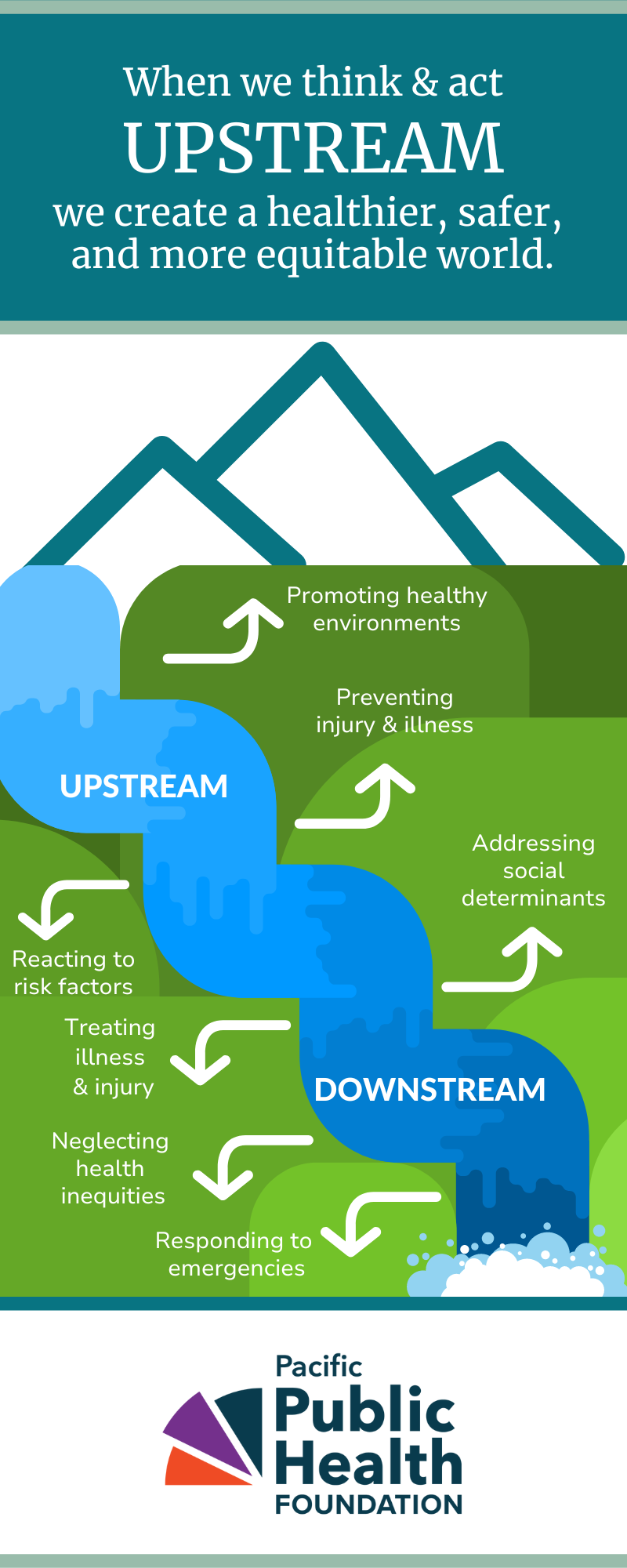We’ve learned a lot over the last few years. Collectively, across the world, people have a better understanding of the importance of public health, what public health does, and why it is critical to invest in initiatives that protect the health of our communities, and society.
But, we still have work to do. Because we can change the tide of today’s crises if we change our thinking about health, where health begins, and what health means.
One way we can do this is by thinking, and acting, upstream.

Upstream has become a key analogy for how we need to think about health. An analogy that encourages us to take action to prevent illness and injury, protect people, promote environments that foster good health, and importantly, to address social injustice, inequities, and the determinants of health.
In our current system, we’re battling against the stream — we treat illness, we fix injuries, we commit resources to problems once they exist. That’s important, and we can’t stop that, but it’s also exhausting. Imagine if we stopped struggling against the current. It’s not complicated or novel; why then do we insist on putting all our effort at the end instead of also at the beginning?
The social determinants of health are critical to upstream thinking. And so is equity. Did you know that most of our health is created by non-medical factors, such as living conditions, income, and gender?
Inequities create conditions in which achieving good health becomes challenging, and indicators of health are poorer. It’s problematic when we only talk about healthy lifestyles, but don’t address the social and environmental factors where a person lives, works, and plays.
We all care about health. We all want to be safe. To achieve that, we must address the factors that influence our health and safety, such as income, education, the environment, social justice, and more. Medical solutions, disease control, behaviour change — these are all imperative for a healthy society. But they aren’t enough. They alone will not create a healthy society. The only way to truly have a healthy world is by addressing the conditions around us.
Upstream action addresses those circumstances.
A simple and widely understood example is early childhood development. When a child is nurtured with the things needed to grow, learn, and thrive, that child matures into a healthy adult. Optimizing a child’s development between 0-8 years old is critical to protecting them later in life. Adolescence is also an important developmental stage where behaviours are established that impact long-term health outcomes and early-life interventions can promote better quality of life. Promoting positive well-being for youth leads to healthier adulthood, and approaches are required that emphasize positive health promotion and strengthening well-being, not merely addressing deficits or illness.
Another is housing. Consider the ‘housing first model’ to address homelessness. This model focuses on getting people housed first, not waiting until other issues are solved (employment, for example) before finding housing. It’s a pretty basic premise: get people in safe and secure housing, where they can then focus on dealing with their other needs, e.g. mental health and substance use. Removing the barrier of housing insecurity and instability lifts people up, reduces the inequality gap, addresses inequities, lessens the burden on healthcare, and gives people a chance to thrive.
Another example is universal basic income. A hot button topic, but the principle of which is to help boost everyone up to a level from which they can make a difference to their own lives and take care of themselves and their families. It’s a social safety net with an emphasis on equity.
Safer supply, or provision of pharmaceutical alternatives to the poisoned unregulated drug supply, is another example whereby a solution is provided ‘upstream’, that prevents overdoses and death, brings people into wrap-around services that can address other issues, mitigates use and costs of emergency and extensive healthcare services, and strengthens community well-being, safety, and equity.
These are just a few examples of upstream actions.
When we think and act upstream, we create a healthier and safer world. Small or big, upstream solutions must become the way of our future. It’s time to start thinking about health in a less traditional way; it’s time for different sectors to work together to create solutions that address inequalities across the social gradient and life course, and ultimately to create a healthy and equitable world.
It’s time to agree that social injustice is a disease, making too many people sick.
In order to create a true ‘health care’ system, it’s time to focus on upstream actions.
